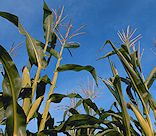
Farmers scouting fields are noting things that look abnormal. Sometimes they turn out to be something worth worrying about, many times they don't. One of those in the 'not to worry' category is apparently ragged leaf edges. Reports of this phenomenon are cropping up here and there over the past couple of weeks.
Bob Nielsen, Purdue University Extension corn specialist, says it's another one of those things that shouldn't affect yield. With so many things to worry about, including tight crop margins and whether or not to spray fungicides, noting leaf edges that are ragged or appear torn is one you can file away and not concern yourself with, he notes.
Some sources have suspected insect damage. Others believes it's wind damage. Sometimes one edge of a leaf is affected, sometimes both edges. Nielsen describes it as "looking like someone was making paper dolls and didn't do a very good job of cutting them out."
There appears to be a genetic tie to this symptom. Some hybrids express it more than others. But the bottom line is that it's harmless, as far as Nielsen knows.
What's not quite as clear is what causes it. His best guess is that a leaf deep in the whorl becomes sticky, or stuck so to speak, and in unfurling as corn grows rapidly, wind sup with jagged edges.
Tom Jordan, Purdue weed control specialist, explains that corn comes out of the whorl during this grand growth phase much like coming out of a periscope. The growing point pushed leaves up inside the whorl. As they reach the top, they unfurl.
Jordan recently examined a totally different condition- corn damaged by what appears to be severe nitrogen burn from an over-the-top application. "Even though drops are used, if there ground is rolling there can be enough up and down action with the booms to get nitrogen splashing up on the corn," he says.
Like ragged edge syndrome, Jordan expects the corn will grow out of it with little or no damage. The only exception might be in cases where the leaves might stick together form decaying tissue, preventing leaves still coming out from unfurling properly. As long as that's not the case, the field should recover in good shape, he concludes.
About the Author(s)
You May Also Like




